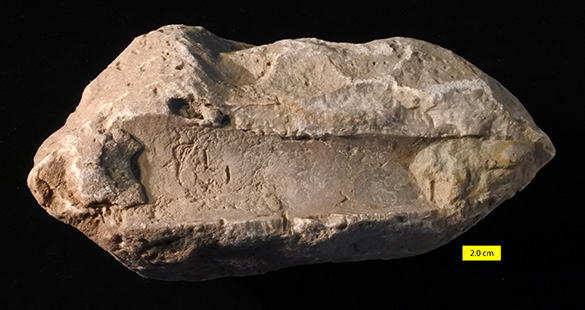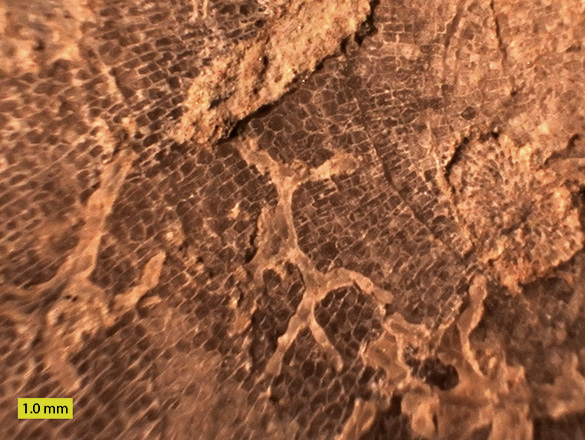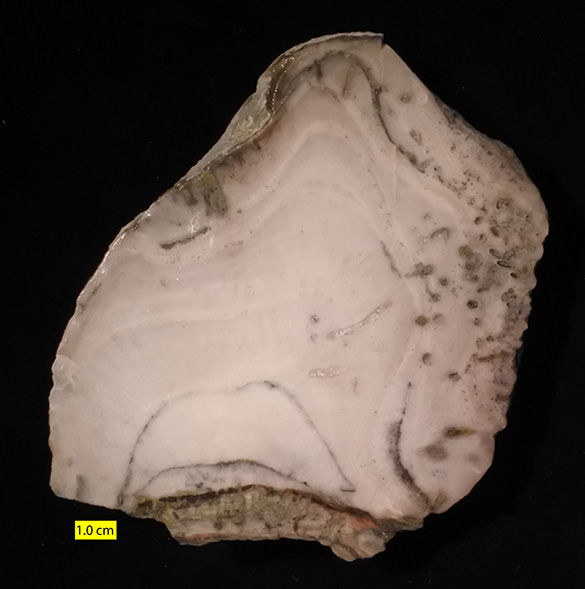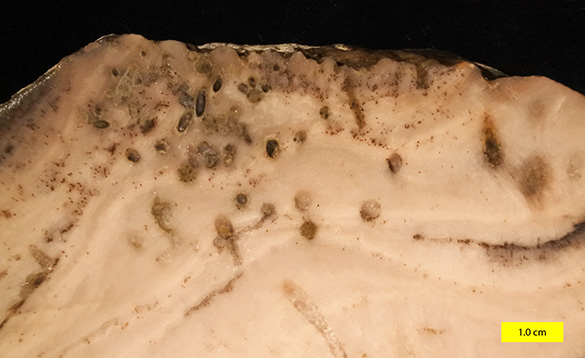 This massive trepostome bryozoan, a solid lump of biogenic calcite, was collected earlier this week on the latest Team Cincinnati field expedition into the treasure-filled Upper Ordovician underlying and surrounding that city. Wooster students Matt Shearer, Luke Kosowatz and I are pursuing projects related to trepostome bryozoans and bioerosion (the biological destruction of hard substrates). The above specimen combines both these worlds, and more. Note the concavity at the base of the specimen. It comes from the Bellevue Formation (Katian) exposed on Bullitsville Road near the infamous Creation Museum (C/W-152).
This massive trepostome bryozoan, a solid lump of biogenic calcite, was collected earlier this week on the latest Team Cincinnati field expedition into the treasure-filled Upper Ordovician underlying and surrounding that city. Wooster students Matt Shearer, Luke Kosowatz and I are pursuing projects related to trepostome bryozoans and bioerosion (the biological destruction of hard substrates). The above specimen combines both these worlds, and more. Note the concavity at the base of the specimen. It comes from the Bellevue Formation (Katian) exposed on Bullitsville Road near the infamous Creation Museum (C/W-152).
 Underneath the bryozoan colony (its zoarium) is this conical impression. It is an external mold of a straight nautiloid conch, the shell of a common squid-like cephalopod during the Ordovician. After the death of the nautiloid its empty tubular conch rested on the seafloor. This hard surface attracted the larvae of a variety of bryozoans that spread their calcitic zoaria (colonial skeletons) across the surface. Eventually one trepostome bryozoan species gained dominance over the space and occupied it all, growing into the large colony we see today. It even wrapped around the aperture of the conch (on the left) and grew a bit into the tube. Since the nautiloid conch was made of unstable aragonite, it long ago dissolved away, leaving an impression (external mold) in the stable calcite of the bryozoan.
Underneath the bryozoan colony (its zoarium) is this conical impression. It is an external mold of a straight nautiloid conch, the shell of a common squid-like cephalopod during the Ordovician. After the death of the nautiloid its empty tubular conch rested on the seafloor. This hard surface attracted the larvae of a variety of bryozoans that spread their calcitic zoaria (colonial skeletons) across the surface. Eventually one trepostome bryozoan species gained dominance over the space and occupied it all, growing into the large colony we see today. It even wrapped around the aperture of the conch (on the left) and grew a bit into the tube. Since the nautiloid conch was made of unstable aragonite, it long ago dissolved away, leaving an impression (external mold) in the stable calcite of the bryozoan.
How do we know there were earlier generations of bryozoans on this conch? We see them exposed upside-down on the surface of the external mold. Above we see the thin, branching cyclostome bryozoan Cuffeyella in the foreground, with a sheet of an encrusting trepostome bryozoan in the background. There are several other earlier bryozoans visible on this surface, revealing an ecological succession. There may be soft-bodied organisms preserved on this surface as well. This locality yielded the first described specimens of bioimmuration in the Ordovician (see Wilson et al., 1994).
 There were other large trepostome bryozoans found in this same locality. I couldn’t resist cutting one in half to see what the inside looked like.
There were other large trepostome bryozoans found in this same locality. I couldn’t resist cutting one in half to see what the inside looked like.
 In this close view of the cross-section through the calcitic trepostome bryozoan we see numerous round holes drilled by some sort of worm seeking protective space so it could filter-feed. (In other words, it was not preying on the bryozoan.) The most intense boring of the specimen appears to have taken place just before and after the death of the colony. We know some borings were excavated into living bryozoan skeleton because the bryozoan formed reactive tissue around the intruder. The very tiny reddish-brown dots scattered in layers are “brown bodies“, the organic remnants of bryozoan polypides in their skeletal tubes (zooecia).
In this close view of the cross-section through the calcitic trepostome bryozoan we see numerous round holes drilled by some sort of worm seeking protective space so it could filter-feed. (In other words, it was not preying on the bryozoan.) The most intense boring of the specimen appears to have taken place just before and after the death of the colony. We know some borings were excavated into living bryozoan skeleton because the bryozoan formed reactive tissue around the intruder. The very tiny reddish-brown dots scattered in layers are “brown bodies“, the organic remnants of bryozoan polypides in their skeletal tubes (zooecia).
It has been a pleasure to return to the extraordinary Cincinnati fossils!
References:
Taylor, P.D. 1990. Preservation of soft-bodied and other organisms by bioimmuration—a review. Palaeontology 33: 1-17.
Wilson, M.A. 1985. Disturbance and ecologic succession in an Upper Ordovician cobble-dwelling hardground fauna. Science 228: 575-577.
Wilson, M.A., Palmer, T.J. and Taylor, P.D. 1994. Earliest preservation of soft-bodied fossils by epibiont bioimmuration: Upper Ordovician of Kentucky. Lethaia 27: 269-270.



Great series of posts and history lessons, thanks Dr. Wilson. We look forward to hearing more about the fossils from Matt and Luke.